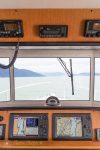The importance of the VHF marine radio for safe boat operation can not be overstated. Learning to use the radio properly is a skill as critical as reading the charts or steering the boat.
The Nordic Quest features two marine radios on the bridge. This adds a layer of redundancy and convenience. Leaving one radio tuned to channel 16, I will often dance across the channels with the second radio. You can listen to the Coast Guard advisories on channel 22A, check the weather, or keep an ear to commercial operation channels when in a port area. I will also use the second radio to listen in on the commercial fishermen or charter boats, attempting to glean useful intelligence information on that all important question… Where are the fish?In Alaska the radio is critical and the chatter on channel 16 is constant. In congested areas I have often been contacted by other boats in order to coordinate maneuvers. I have talked to everything from tugboats and ferries to the massive cruise ships, and on several occasions the Coast Guard. I have been other places, such as the waters around Kona, where there is almost no radio traffic despite quite a few boats out on the water. I have even been on boats where the radio is not even turned on. After learning navigation in Alaska this just seems so wrong.
Both radios are ICom IC-M504 marine radios. Operation of the radios is easy. Turn them on and select the channel with the big knob. It is also a good idea to regularly check the squelch setting, adjusting it as low as you can to pick up faint calls. I usually set the port radio to channel 16 for hailing and use starboard for whatever else I want to listen to. I replaced the starboard antenna on the Quest a few years back and I think it is a little more sensitive than port.In the upper right corner of each radio is a red distress button protected by a little flip-up cover. In the case of a true emergency just lift the cover and mash the button. The radio will broadcast an automatic distress call to all boats nearby and the Coast Guard. Included in the message will be the Quest’s coordinates from the navigation system GPS. We have heard this message come in from another boat, it made a lot of noise on our bridge. It also linked the coordinates to the Furuno nav system and put an icon on our electronic chart at the location of the vessel broadcasting the distress call. Not a replacement for a proper distress call, but a potentially lifesaving addition.
There is a waterproof handheld marine radio aboard the Quest as well. This should be carried by the launch operator or shore parties. The additional safety factor here is significant, the ability to communicate with the boat is potentially critical. Leaving one radio on channel 16 we will set the second bridge radio for the handheld (usually channel 68) and turn up the volume a bit. Thus shore parties can check-in, request pickup by the launch, or summon help.
In recent years I have also brought a second handheld with me. A Baofeng UV-82 handheld with a longer whip antenna. This inexpensive programmable UHF/VHF radio can be programmed for the marine channels allowing even longer range. This range can be quite good, allowing me to let the boat know that all is well on longer hikes ashore. This summer I was able to check-in from the beach at Sealion Cove to the boat in Kalinin Bay even with a two thousand foot mountain directly in the way.


